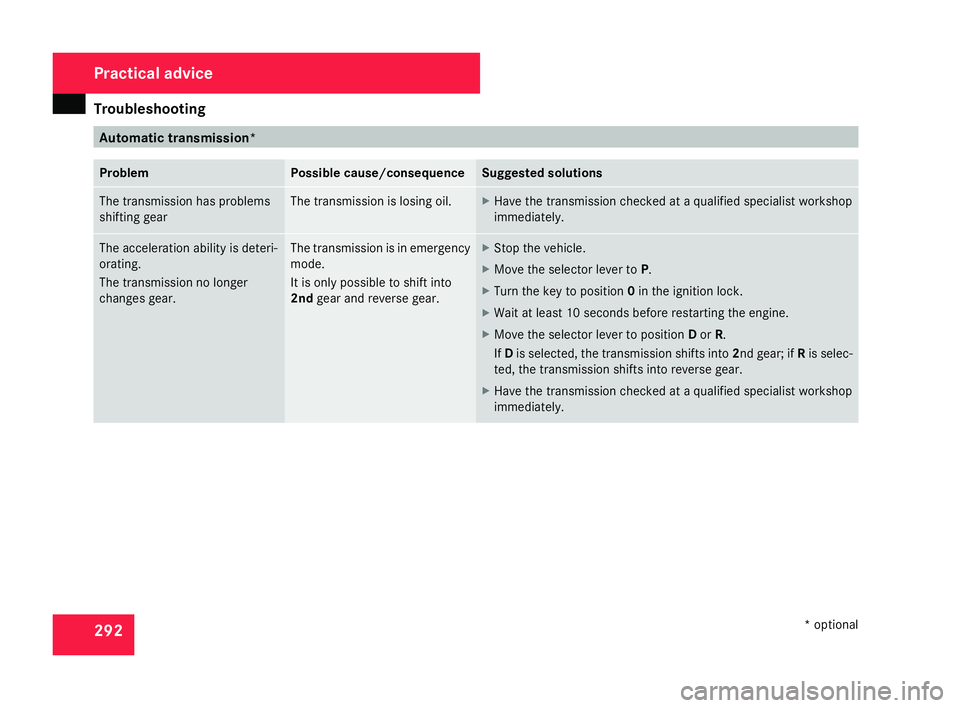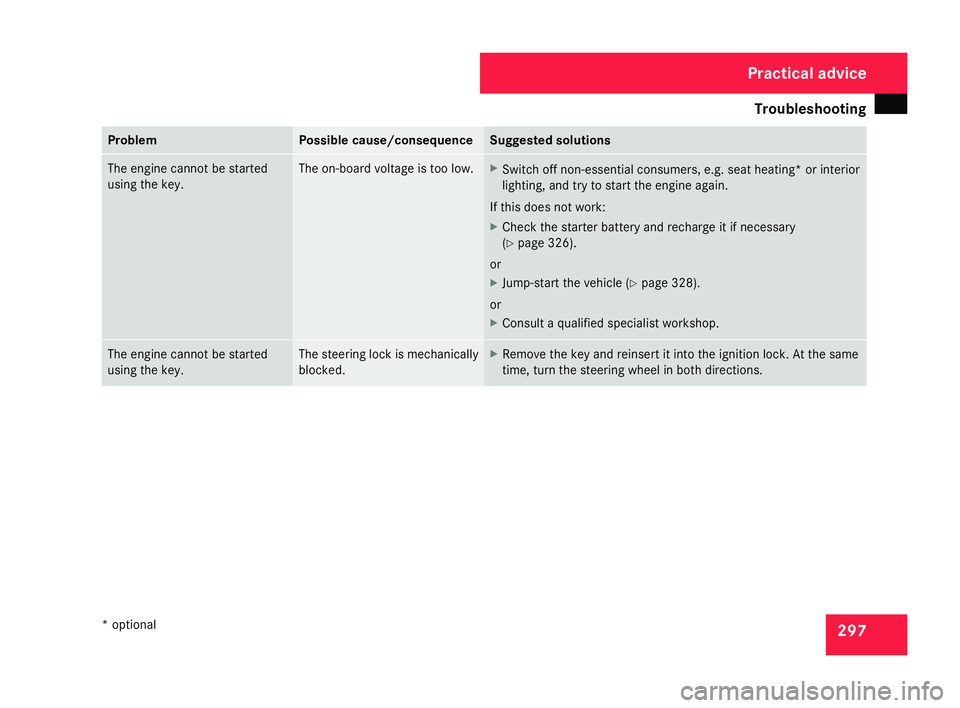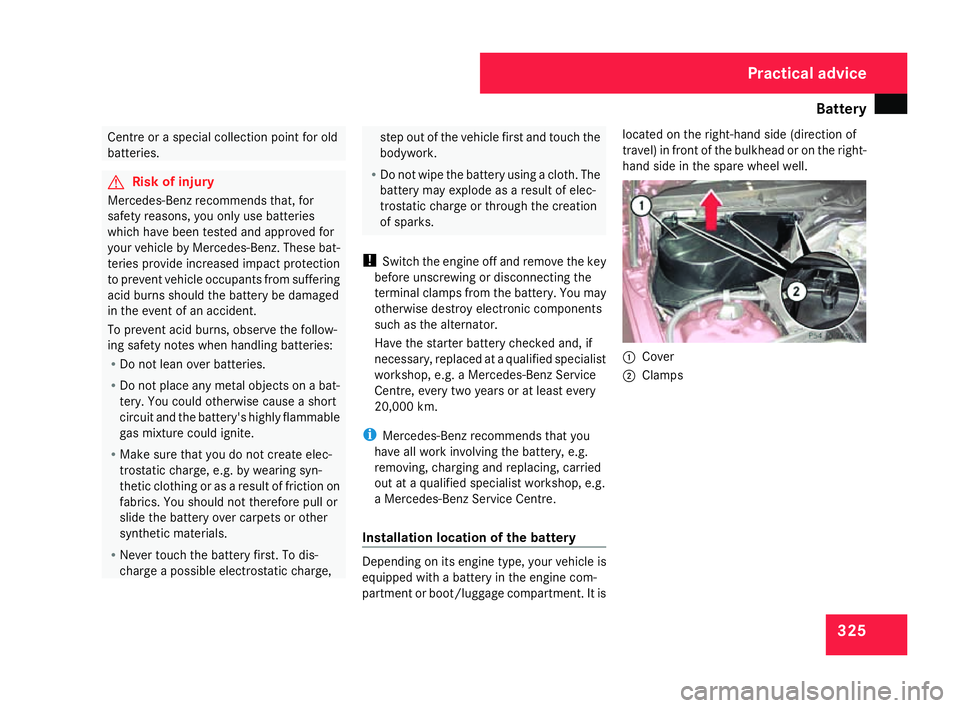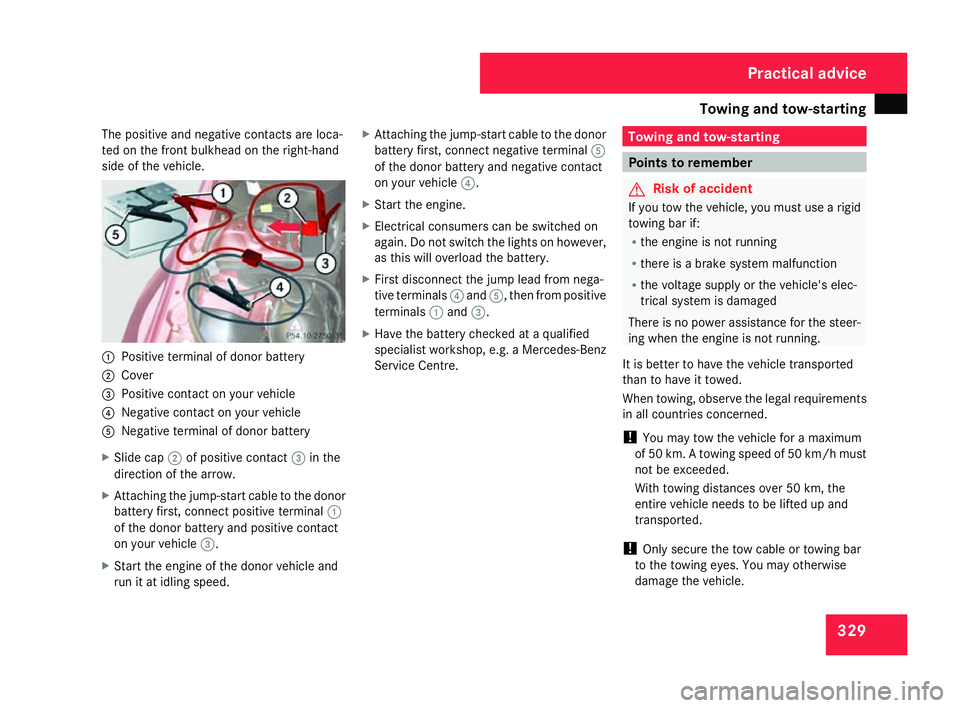check engine MERCEDES-BENZ C-CLASS SALOON 2007 Owner's Manual
[x] Cancel search | Manufacturer: MERCEDES-BENZ, Model Year: 2007, Model line: C-CLASS SALOON, Model: MERCEDES-BENZ C-CLASS SALOON 2007Pages: 377, PDF Size: 6.19 MB
Page 295 of 377

Troubleshooting
29
2 Automatic transmission
*Problem Possible cause/consequence Suggested solutions
The transmission has problems
shifting gear The transmission is losing oil. X
Have the transmission checked at a qualified specialist workshop
immediately . The acceleration ability is deteri-
orating.
The transmission no longer
changes gear. The transmission is in emergenc
y
mode.
It is only possible to shift into
2nd gear and reverse gear. X
Stop the vehicle.
X Move the selector lever to P.
X Turn the key to position 0in the ignition lock .
X Wait at least 10 seconds before restarting the engine.
X Move the selector lever to position Dor R.
If D is selected, the transmission shifts into 2nd gear; if Ris selec -
ted, the transmission shifts into reverse gear .
X Have the transmission checked at a qualified specialist workshop
immediately . Practical advice
* optional
204_AKB; 2; 3, en-GB
mkalafa,
2007-06-26T23:11:51+02:00 - Seite 292
Page 300 of 377

Troubleshooting
29
7 Problem Possible cause/consequence Suggested solutions
The engine cannot be started
using the key. The on-board voltage is too low. X
Switch off non-essential consumers, e.g. seat heating* or interio r
lighting, and try to start the engine again.
If this does not work :
X Check the starter battery and recharge it if necessary
(Y page 326).
or
X Jump-start the vehicle (Y page 328).
or
X Consult a qualified specialist workshop. The engine cannot be started
using the key. The steering lock is mechanically
blocked. X
Remove the key and reinsert it into the ignition lock. At the sam e
time, turn the steering wheel in both directions. Practical advice
* optional
204_AKB; 2; 3, en-G
B
mkalafa , 2007-06-26T23:11:51+02:00 - Seite 297
Page 328 of 377

Battery
32
5 Centre or a special collection point for old
batteries . G
Risk of injury
Mercedes-Benz recommends that, for
safety reasons, you only use batteries
which have been tested and approved for
your vehicle by Mercedes-Benz. These bat-
teries provide increased impact protectio n
to prevent vehicle occupants from suffering
acid burns should the battery be damage d
in the event of an accident .
To prevent acid burns, observe the follow-
ing safety notes when handling batteries:
R Do not lean over batteries .
R Do not place any metal objects on a bat-
tery. You could otherwise cause a short
circuit and the battery's highly flammabl e
gas mixture could ignite.
R Make sure that you do not create elec-
trostatic charge, e.g. by wearing syn-
thetic clothing or as a result of friction on
fabrics. You should not therefore pull or
slide the battery over carpets or other
synthetic materials.
R Never touch the battery first. To dis-
charge a possible electrostatic charge, step out of the vehicle first and touch the
bodywork.
R Do not wipe the battery using a cloth. Th e
battery may explode as a result of elec-
trostatic charge or through the creation
of sparks .
! Switch the engine off and remove the key
before unscrewing or disconnecting the
terminal clamps from the battery. You may
otherwise destroy electronic components
such as the alternator.
Have the starter battery checked and, if
necessary, replaced at a qualified specialist
workshop, e.g. a Mercedes-Benz Service
Centre, every two years or at least every
20,000 km.
i Mercedes-Benz recommends that you
have all work involving the battery, e.g.
removing, charging and replacing, carried
out at a qualified specialist workshop, e.g.
a Mercedes-Benz Service Centre.
Installation location of the battery Depending on its engine type, your vehicle is
equipped with a battery in the engine com-
partment or boot/luggage compartment. It islocated on the right-hand side (direction of
travel) in front of the bulkhead or on the right-
hand side in the spare wheel well.
1
Cove r
2 Clamps Practical advice
204_AKB; 2; 3, en-GB
mkalafa,
2007-06-26T23:11:51+02:00 - Seite 32
5
Page 332 of 377

Towing and tow-startin
g 329
The positive and negative contacts are loca-
ted on the front bulkhead on the right-han d
side of the vehicle. 1
Positive terminal of donor batter y
2 Cove r
3 Positive contact on your vehicle
4 Negative contact on your vehicle
5 Negative terminal of donor battery
X Slide cap 2of positive contact 3in the
direction of the arrow.
X Attaching the jump-start cable to the donor
battery first, connect positive terminal 1
of the donor battery and positive contact
on your vehicle 3.
X Start the engine of the donor vehicle and
run it at idling speed . X
Attaching the jump-start cable to the donor
battery first, connect negative terminal 5
of the donor battery and negative contact
on your vehicle 4.
X Start the engine.
X Electrical consumers can be switched on
again. Do not switch the lights on however ,
as this will overload the battery.
X First disconnect the jump lead from nega -
tive terminals 4and 5, then from positiv e
terminals 1and 3.
X Have the battery checked at a qualified
specialist workshop, e.g. a Mercedes-Benz
Service Centre. Towing and tow-starting
Points to remember
G
Risk of accident
If you tow the vehicle, you must use a rigid
towing bar if:
R the engine is not running
R there is a brake system malfunctio n
R the voltage supply or the vehicle's elec-
trical system is damage d
There is no power assistance for the steer-
ing when the engine is not running.
It is better to have the vehicle transported
than to have it towed.
When towing, observe the legal requirement s
in all countries concerned.
! You may tow the vehicle for a maximum
of 50 km. A towing speed of 50 km/h must
not be exceeded.
With towing distances over 50 km, the
entire vehicle needs to be lifted up and
transported.
! Only secure the tow cable or towing bar
to the towing eyes. You may otherwise
damage the vehicle. Practical advice
204_AKB; 2; 3, en-GB
mkalafa,
2007-06-26T23:11:51+02:00 - Seite 329